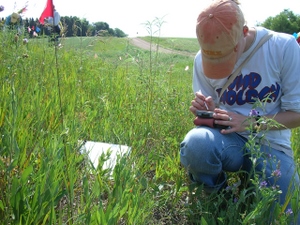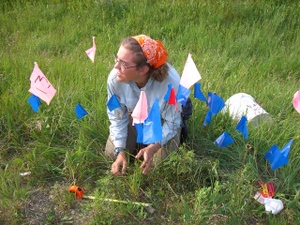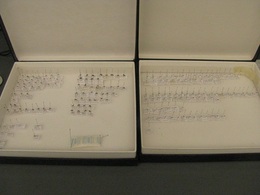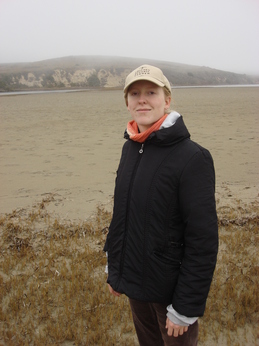|
|
Today volunteers Bill and Bob spent the morning respectively cleaning and counting Echinacea achenes. Bill (pictured below) came across a receptacle that had a big hole in it–probably due to a burrowing critter:


In other news, Shona Sanford-Long, one of the 2012 summer REU interns, is here in the lab working on her Echinacea hybridization project. She spent the morning meticulously extracting achenes from the Echinacea pallida x angustifolia crosses she performed last summer.
We are no longer accepting applications for this position.
Please read about our current opportunities!
Are you interested in gaining field research experience and learning about the ecology and evolution of plants in fragmented prairie habitat? If you are, then this might be the opportunity you are looking for!
The Echinacea Project is looking for interested and enthusiastic summer field researchers for the 2013 summer field season. Our project investigates how small population size and reduced genetic diversity influence individual fitness, population demographics, plant-insect interactions and evolution in the purple coneflower Echinacea angustifolia. This is a great internship or summer co-op for aspiring ecologists, conservation biologists, and evolutionary biologists!
Qualifications: College student or recent graduate, wants to work outdoors, is patient, has good hand-eye coordination and fine motor skill, willing to work hard even in inclement or hot conditions, and interested in ecological research. No experience is necessary, but you must be enthusiastic and hard-working.
Dates: The main field season runs from June to the last half of August. We will have one or two positions that will extend to early October. The exact start and end dates are negotiable.
Money: There is a $440/week stipend and housing is supplied.
 Laura taking data on seedling survival Job Description
The main research project is to determine evolutionary and ecological consequences of habitat fragmentation on purple coneflower, a beautiful and relatively common prairie flower. The research site is in western Minnesota. Stuart Wagenius is the field supervisor.
The narrow-leaved purple coneflower, Echinacea angustifolia, grows in the former tallgrass prairie and plains of North America, a habitat now fragmented by human activities such as agriculture, development, and roads. Echinacea now exists in isolated populations of various size. We know that seed production in isolated plants is limited by pollination and that genetic diversity is lower in small populations compared to large populations. We still don’t know the long-term consequences of reduced seed set, low-fitness seedlings, and reduced genetic diversity on the persistence of these populations.
During this summer, we will systematically map over 2000 plants in natural populations that have been observed for the past fourteen years to compare the fecundity and mortality of plants in small and large populations. For another ongoing project, we will measure growth, flowering, and fitness traits of plants growing in research plots. The goal of this project is to estimate the genetic and environmental influences on Echinacea plants originating from small and large remnant populations. In addition to measuring plants and collecting data, we will maintain plots by mowing and weeding.
You will gain skills in identifying plants, surveying natural plant populations, measuring plant traits in experimental plots, hand-pollinating plants, and observing & collecting insects. You will learn many techniques for experimental field work in plant ecology, genetics, and plant-insect interactions. Specific skills you may gain include collecting seed, surveying and GPS techniques, artificially pollinating flowers, identifying insects, mapping plants, characterizing communities, gaining appreciation for long-term experiments, and working as part of a team.
Living: The study area is a rural agricultural community. The closest towns are Kensington (56343) and Hoffman (56339), MN. Alexandria, a larger town with a movie theater, is 20 miles away. In Solem township there are dirt roads, a highway, railroad tracks, wetlands, and lots of corn and soybeans. There are prairie remnants scattered throughout the township. You’ll live in a house with basic amenities and basketball hoop. You’ll share the common area with other team members, but you’ll have your own space and a bed. Usually we’ll eat lunch together at our base station.
 Rachel mapping seedlings How to apply
Ask yourself if you love being outdoors, if you are patient, if you can work independently, if you are willing to work hard in adverse conditions, and if you could be enthusiastic about this job. If you answer yes to these questions and you still want the job, please apply. Your application should include:
- a cover letter, including the following…
- why you’re interested
- what your future plans are
- when you can start and end
- whether you are interested in an independent project
- who will serve as your references
- your email and phone number
- your resume
- your transcript (unofficial OK)
- one letter of recommendation (sent by recommender)
Send your application via email to echinaceaProject@gmail.com by 28 February 2013.
Students who are now and will be undergraduates in Fall 2013, should consider an REU internship.
Review of applications will begin on 28 February 2013. We’ll accept applications until positions are filled. Be sure to include an email address and phone number where you can be reached during March.
Members of groups underrepresented in science are particularly encouraged to apply.
 Team Echinacea 2006: Andrea, Christina, Jennifer, Rachel, Aki, Rachel, Laura, Gretel (L – R) More information
If you have any questions, contact Stuart via e-mail or phone (847-835-6978).
Go to the Echinacea Project’s homepage to read more about this NSF-funded project. You can also read about this project’s background and papers.
Photos of recent summer field researchers
This summer, REU student Jill Gall put together a large collection of ants from prairie remnants in Minnesota. Yesterday, Stuart and I headed over to Lakeforest College to seek the advice of resident ant ecologist Sean Menke. Jill left us with two boxes of ants, which she pinned and identified to genus and separated into morphotypes:

Sean was impressed with her identification skills: she was correct in nearly every identification to genus and many of her morphotypes were consistent. He gave us some tips on what traits to look for when identifying ants. Now we have a plan for going through the rest of the collection. This will allow us to compare the species diversity of ants among prairie remnants, and hopefully pave the way for future ant research in the lab.

After a fairly cool start, we enjoyed a sunny and mild day that was perfect for field work.
Katherine was finishing up with the ants and aphids at Staffanson today. Karen continued pollination treatments on Helianthus species at Hegg Lake and Riley. The team worked on demography at various sites, pulling flags and taking GPS points.
We can’t wait to hear how about the REU symposium at the Chicago Botanic Garden that Jill and Andrew are attending today!
Today, we say farewell to yet another Team Echinacea 2012 member as Shona heads off to Vermont. The end of field season seems to be near…….
Here is my poster for the University of Minnesota symposium. I may make some changes for the Chicago Botanic Garden symposium, but that depends on how much more data I get through by the 17th. Jillian Gall_REU Poster_Small.pdf
Here’s my summer project proposal explaining my work with the ants in the prairie. I still need to tighten up the methods a bit, so keep an eye out for updated versions!
JG_REU Project Proposal 2012.pdf
I don’t know if I’ve properly introduced myself on here.
My name is Katherine Muller and I’m a second year Master’s student at Northwestern. I hail from the lovely, temperate San Francisco Bay Area. I’m not sure whether it was my thirst for adventure or my contrarian nature that led me to the Midwest–first to Oberlin College in Ohio, then to Northwestern and Minnesota. In any case, I now have the privilege of complaining about the weather.
This is my second year with the Echinacea Project. Last year I began research on aphids and ants in Echinacea angustifolia. I have two projects that I plan to continue this summer:
My first project is an experiment examining the effects of aphid infestation on Echinacea. Last year, I selected 100 non-flowering Echinacea, excluded aphids from 50 plants and added aphids to the other 50. I am repeating the experiment on the same plants. I performed my first experimental treatments on Saturday and Sunday and should soon be able to analyze my results from last year.
The other project I plan to continue this year is a survey of aphids and ants in a large experimental common garden. Last year I selected a 20x20m section of the experimental plot and led a biweekly of ants and aphids. I started this because I was interested in seeing how aphids spread over space and time. This year I will examine the same area to see how aphid infestation changes from year to year. Thanks to everyone’s help, I collected my first dataset on June 15th. Considering the unusually warm winter, there should be some interesting developments this year.
My third project is to assess aphid and ant abundance among several Echinacea populations. My original plan was to survey aphids and ants on a representative sample of the entire population, including juvenile and non-flowering plants. As it so happens, Amy Dykstra and Daniel Rath conducted a similar survey in 2009 (you can read about it in the archives). For all their hard work, they found very few plants with aphids. Of the plants they surveyed–flowering plants had a much higher rate of aphid infestation than non-flowering plants–32% for flowering versus 5% for non-flowering plants. I decided to take a different approach and focus my sampling effort on flowering plants. Specifically, I will survey aphid and ant abundance on plants that flowered this year and last year. This will allow me to assess whether flowering in one year influences the likelihood of aphid infestation the following year.
That’s about it for now. I’ll be posting my progress on here as it happens. This summer I have the privilege of collaborating with Jill Gall, an REU student from College of the Atlantic. She’s been hard at work preparing her project assessing ant diversity in prairie remnants, which I’ll let her tell you about.
And because everyone else is doing it, here’s a picture:

I am slow to arrive at K-town this year because I am in transition of careers. I am moving from Great Plains Lutheran HS in Watertown, SD to Martin Luther College in New Ulm, MN where I will be a teaching professor in the biology department. I am excited to teach ecology in the fall with a summer background with team echinacea. I will still be only about 150 miles from K-town, just a different direction. I look forward to meeting the 2012 team and starting to help with projects. Our family moved the earthly possessions last week and we are settling in after making a wedding/reunion trip to Wisconsin.
The Echinacea Project posted job descriptions for field research internships for summer 2012 along with details about how to apply. Applications will be reviewed starting 29 February 29, 2012 and will be accepted until positions are filled.
The text of an ad to be distributed is copied here…
Are you interested in gaining field research experience and learning about the ecology and evolution of plants and plant-animal interactions in fragmented prairie? We are looking for 3-5 summer field researchers for an NSF-funded project on habitat fragmentation of the tallgrass prairie. We are investigating how small plant population size influences inbreeding, demography, pollination, and herbivory in the purple coneflower, Echinacea angustifolia. This is a great summer internship, REU, or co-op for those interested in field biology or conservation research.
No experience is necessary, but you must be enthusiastic and hard-working. You will survey natural plant populations, measure plant traits in experimental plots, hand-pollinate plants, observe & collect insects, and assist in all aspects of research. Housing is provided and there is a stipend. Undergraduate students have the opportunity to do an independent project as an REU participant.
We are no longer accepting applications for this position.
Please read about our current opportunities!
Are you interested in gaining field research experience and learning about the ecology and evolution of plants in fragmented prairie habitat? If you are, then this might be the opportunity you are looking for!
The Echinacea Project is looking for interested and enthusiastic summer field researchers for the 2012 summer field season. Our project investigates how small population size and reduced genetic diversity influence individual fitness, population demographics, plant-insect interactions and evolution in the purple coneflower Echinacea angustifolia. This is a great internship or summer co-op for aspiring ecologists, conservation biologists, and evolutionary biologists!
Qualifications: College student or recent graduate, wants to work outdoors, is patient, has good hand-eye coordination and fine motor skill, willing to work hard even in inclement or hot conditions, and interested in ecological research. No experience is necessary, but you must be enthusiastic and hard-working. Several spots are reserved for current undergraduate students interested in conducting their own research project–see details below.
Dates: The main field season runs from mid-June to the last half of August. We may hire one person to start in May to help with a seedling recruitment experiment. The exact start and end dates are negotiable.
Money: There is a $440/week stipend and housing is supplied.
 Laura taking data on seedling survival Job Description
The main research project is to determine evolutionary and ecological consequences of habitat fragmentation on purple coneflower, a beautiful and relatively common prairie flower. The research site is in western Minnesota. Stuart Wagenius is the field supervisor.
The narrow-leaved purple coneflower, Echinacea angustifolia, grows in the former tallgrass prairie and plains of North America, a habitat now fragmented by human activities such as agriculture, development, and roads. Echinacea now exists in isolated populations of various size. We know that seed production in isolated plants is limited by pollination and that genetic diversity is lower in small populations compared to large populations. We still don’t know the long-term consequences of reduced seed set, low-fitness seedlings, and reduced genetic diversity on the persistence of these populations.
During this summer, we will systematically map over 2000 plants in natural populations that have been observed for the past fourteen years to compare the fecundity and mortality of plants in small and large populations. For another ongoing project, we will measure growth, flowering, and fitness traits of plants growing in research plots. The goal of this project is to estimate the genetic and environmental influences on Echinacea plants originating from small and large remnant populations. In addition to measuring plants and collecting data, we will maintain plots by mowing and weeding.
You will gain skills in identifying plants, surveying natural plant populations, measuring plant traits in experimental plots, hand-pollinating plants, and observing & collecting insects. You will learn many techniques for experimental field work in plant ecology, genetics, and plant-insect interactions. Specific skills you may gain include collecting seed, surveying and GPS techniques, artificially pollinating flowers, identifying insects, mapping plants, characterizing communities, gaining appreciation for long-term experiments, and working as part of a team.
Independent project: If you are interested, you will have the opportunity to work on an independent research project on your own or in a group. Projects can explore questions about the ecology and evolutionary biology of Echinacea angustifolia, another prairie plant species, or plant associated insects. All work occurs in the context of prairie remnants which allows projects to be directly applicable to conservation challenges of habitat fragmentation. Here are some examples of past projects: “Insect diversity in prairie remnants,” “The effect of remnant size on the diversity of Echinacea-visiting ant species,” “Effect of inbreeding on symmetry of floral display,” and “Competition between Echinacea and thistles for pollinators.”
Living: The study area is a rural agricultural community. The closest towns are Kensington (56343) and Hoffman (56339), MN. Alexandria, a larger town with a movie theater, is 20 miles away. In Solem township there are dirt roads, a highway, railroad tracks, wetlands, and lots of corn and soybeans. There are prairie remnants scattered throughout the township. You’ll live in a house with basic amenities and basketball hoop. You’ll share the common area with other team members, but you’ll have your own space and a bed. Usually we’ll eat lunch together at our base station.
 Mimi, Daniel, Kate, and Allegra REU Program Details
Every year we reserve several spots on the team for undergraduate students interested in conducting an independent research project. The Echinacea Project offers a great opportunity for independent field research projects and the REU opportunity is excellent for aspiring ecologists, conservation biologists, and evolutionary biologists! In addition to housing and stipend, travel expenses to the research site will be covered. Start and end dates are flexible.
To apply for this opportunity please follow the general application procedure and indicate your interest and eligibility in the REU program. During the summer, an REU participant must be enrolled in an undergraduate institution and be a US citizen or permanent resident of the US or its possessions. Members of underrepresented groups are particularly encouraged to apply.
To increase your chances of working on the Echincaea Project as an REU, you should also apply to the REU program at the Chicago Botanic Garden…
 Caroline and Greg searching for seedlings CBG program details
This research opportunity involves 2 weeks at the Chicago Botanic Garden (CBG) and 8 weeks at the field site in Minnesota. You will start at CBG on June 11th and learn about techniques in field botany and design your independent project in consultation with Stuart. Then you will conduct field work in Minnesota and work with the Echinacea Project team. In August you will return to CBG to present your poster.
In addition to the stipend and housing, travel and some food expenses are provided.
To apply, visit the CBG REU website and follow the directions. Due date: 31 January 2012. Be sure to select a project mentored by Wagenius as a top choice, like this one or this one!
To be eligible for the CBG REU position you must be enrolled in an undergraduate institution and be a US citizen or permanent resident of the US or its possessions during the summer. Members of underrepresented groups are particularly encouraged to apply.
 Rachel mapping seedlings How to apply
Ask yourself if you love being outdoors, if you are patient, if you can work independently, if you are willing to work hard in adverse conditions, and if you could be enthusiastic about this job. If you answer yes to these questions and you still want the job, please apply. Your application should include:
- a cover letter, including the following…
- why you’re interested
- what your future plans are
- when you can start and end
- whether you are interested in an independent project
- if you’re interested and eligible for an REU
- who will serve as your references
- your email and phone number
- your resume
- your transcript (unofficial OK)
- one letter of recommendation (sent by recommender)
Send your application via email to echinaceaProject@gmail.com by 29 February 2012.
Review of applications will begin on 29 February 2012. We’ll accept applications until positions are filled. Be sure to include an email address and phone number where you can be reached during March.
Members of groups underrepresented in science are particularly encouraged to apply.
 Team Echinacea 2006: Andrea, Christina, Jennifer, Rachel, Aki, Rachel, Laura, Gretel (L – R) More information
If you have any questions, contact Stuart via e-mail or phone (847-835-6978).
Go to the Echinacea Project’s homepage to read more about this NSF-funded project. You can also read about this project’s background and papers.
Photos of recent summer field researchers
Here’s a brief field equipment list from 2004.
|
|










